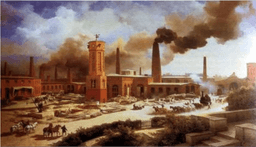
Industrial Revolution Test Review
Quiz by Cyndy
Feel free to use or edit a copy
includes Teacher and Student dashboards
Measure skillsfrom any curriculum
Measure skills
from any curriculum
Tag the questions with any skills you have. Your dashboard will track each student's mastery of each skill.
With a free account, teachers can
- edit the questions
- save a copy for later
- start a class game
- automatically assign follow-up activities based on students’ scores
- assign as homework
- share a link with colleagues
- print as a bubble sheet
40 questions
Show answers
- Q1Who improved the steam engine?Karl MarxJames WattEli WhitneyAdam Smith30s
- Q2Capitalism fueled industrialization byEncouraging entrepreneurs to establish businessesEnsuring all workers received high wagesGiving the country many natural resourcesRequiring inventors to file patents30s
- Q3During the Industrial Revolution, farmers in the United States worked to increase their land holdings and modernize their equipment. What was a lasting effect of these changes?Greater productivity of farmingHigher prices for cropsIncreased rural population densityA shortage of land for farming30s
- Q4What is one effect of industrialization in the United States in the late 19th century?An increase in urbanizationA decrease in child laborA decrease in immigration to the United StatesAn increase in demand for handicraft goods30s
- Q5Why was the formation of labor unions an effect of U.S. industrialization in the late 1800s?Factory owners set up labor unions in order to control their large workforceUnions organized industrial workers to protest unsafe working conditions and long workdays.Union were needed to guarantee a steady supply of workersUnion membership was required for employment in new industries30s
- Q6As farms became mechanized, which of the following happened as a result?Immigrants bought more landFarm workers became rural entrepreneursFarmers moved to urban areasMore people become farmers30s
- Q7What problem arising from U.S. industrialization did the progressive reformers of the late 19th and early 20th centuries want the federal government to address?Lack of capital for railroad expansionUnfair taxes on the wealthyRestrictions on the use of natural resourcesUse of child labor in the workplace30s
- Q8What are the spinning jenny and spinning mule examples of?Socioeconomic changesCommunication advancesTechnological advancesCultural changes30s
- Q9In the late 1800s, why did workers tolerate poor wages?Were tricked by employers into taking dangerous jobsCould be replaced easily by other workersThought that the government would protect themBelieved it had to get worse before it got better30s
- Q10Labor unions formed as a way to help workersLearn more skilled tradesImprove their working conditionsFind better jobsIncrease the hours children could work30s
- Q11The Industrial Revolution began in which country?Great BritainFranceUnited StatesJapan30s
- Q12Which of the following was NOT an effect of the Industrial Revolution?An increasing number of people worked in factoriesAn increasing number of people lived in citiesAn increasing number of people left the family farmsAn increasing number of people worked on family farms30s
- Q13When the Industrial Revolution began, growing cities were often located close to what other resource?farmlandcoal and iron mineschild laboroil wells30s
- Q14How did population growth affect industrial cities?Population growth resulted in more schoolsPopulation growth led to overcrowded, unsanitary living conditionsPopulation growth created more jobsPopulation growth encouraged migration to rural areas30s
- Q15The expansion of the Industrial Revolution was the result of..?better working conditionsa ban on child laborreliance on a family-based economyimproved transportation30s